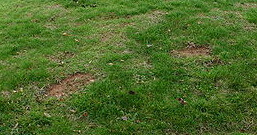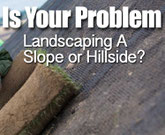Plants for a slope to help stabilise the soil and stop erosion
shade / clay / pathways / Winter colour / dry / sandy soil / chalky soil / bog gardens / ground cover /
Make the most of gardens with steep banks and slopes.
If your gardens has steep banks and slopes, choosing the right plants, planting and maintaining them can be challenging for even the most experienced gardeners. I personally prefer slopes to a flat "green-lawn-man" type of garden. So in this article I will mainly be looking at ways to keep the slopes and plant them with plants that will not only thrive on slopes but are low maintenance and provide a long term solution to erosion of the soil. However I will also look at and point toward my articles that suggest other methods to make a sloping garden a place with space to enjoy.
The main problems with sloping gardens and the solutions.
The problems with sloping gardens and the solutions.
- Lack of safe play space for the kids.
- Nowhere to site a BBQ and entertain guests.
- Water running of the slope causing water logged boggy areas at the bottom.
- Soil erosion the loss of topsoil and turf sliding down the slope. It is a natural process caused by rain and wind and often us, trampling all over the loose dry soil.
The solutions.
- The solution to problems numbers 1 and 2 will be to create space by building Retaining Walls to create terraces, this will obviously also solve the erosion problem. I have covered this in a lot more detail on this page leveling sloping gardens.
- The solution to number 3, see the water running down the slope in the photo, is first to install a french drain. (Read my article how to install lawn and garden drainage) to carry the water away and then to consider terracing or planting the slope. maybe a combination of drainage, terracing and planting.
- The Solution to number 4 Soil erosion could be a combination of terracing and selecting deep-rooted groundcover, shrubs and trees. Both will work effectively, it depends on what you want from your garden,
- planting deep-rooting plants on garden slopes is the easiest and by far the cheapest solution.
The easiest plant for a slope is grass



On a steep slope it's probably not realistic or safe to expect to maintain a formal close mown lawn but there is another way to grow an attractive lawn on a slope. A wildflower lawn, doesn't just look good but is great for Bees and Butterflies and other wildlife and it only needs strimming once a year.
There are several ways to plant a wildflower lawn.
- I have described the way I planted my wildflower lawn here growing a wildflower lawn
- Sowing seed directly onto prepared earth is one easy way, more detail here.
- On a sleep slope laying a biodegradable seeded mat makes the job a lot easier information here,
- An existing grass bank or slope can be planted with wildflower plug plants and bulbs that will naturalise like crocus, snowdrops and bluebells.
Trees,shrubs,ground cover and decorative plants for planting on slopes that will look good and help stabilise the soil
Plant a few deep rooting trees, shrubs, and ground cover plants in the grass selected from the lists on this page they look good, attract birds and help reduce erosion.
- Trees and shrubs include Burning Bush, Fragrant Sumac, Japanese Yew, California Lilac, Creeping Juniper, Dwarf Forsythia, Snowberry Siberian Carpet Cypress.
- Ground cover includes Prostrate Rosemary, Dwarf Coyote, Bush inca, Creeping Myoporum, Rockrose Cotoneaster, English Ivy and for Shady areas try Japanese Pachysandra, Vinca Beach, Strawberry Kinnikinnik.
- Ornamental Grasses can include Red Fescue, Little Bluestem, Switchgrass, Canada Wildrye.
- These decorative plants will need a bit of extra care as they establish but will look good and also help stabilise soil on a slope, Violets Daylilies Deadnettle Roses Spring bulbs Coneflower Russian Sage
My two main considerations when planting a slope that is difficult to access are; low-maintenance and deep-rooting, but I also try to take nature into account by planting a combination of trees, shrubs, and ground covers to attract the birds and the bees and break the rainfall, which reduces erosion.
Things to bear in mind when choosing plants for sloping gardens
Bear these factors in mind when planting on a slope
- Slopes are usually very dry at the top when it hasn't rained and very wet, even swampy toward the bottom of the slope when it does rain. So choose plants that tolerate dry weather for the top 2/3rd and plants that will survive damp soil for the bottom third.
- Tall plants with a widespread are best avoided as they will eventually topple over, tall plants with a deep root system are OK.
- If soil erosion is causing problems it is a good ideal to plant deep rooting plants and avoid shallow rooting plants like ivy that will gradually suffocate slower-growing beneficial plants.
- Flowering plants can do well on sloped ground, but will require mulching and regular tending until established.
plants for planting on a slope
Using the correct plants can help to control soil erosion.
Planting on a slope involves a bit of trial and error, but the plants listed here will take a bit of the guesswork out of it.
Creeping phlox is evergreen with dark green to bluish leaves and blooms from early spring to early summer with flowers that are white, pink, red or bluish-lavender. It grows to about 6" and spreads quickly and is best planted one to two feet apart.
Weeds and Wildflowers
Clover, thistles, plantains, pussytoes, yarrow, violets and other native species do well on sloped ground. Although we know them as weeds, some of these hardy plants produce lovely wildflowers and are very effective at controlling soil erosion.
Plants like artemesias and soft wooly lambs ears with grey or silver foliage add contrasting colour against brighter blooms and dwarf evergreen shrubs.
Birdbaths, bird feeders, big flowerpots and trellises all add interest, but don't go over the top in a small sloped garden. Too much clutter makes it look smaller, design tips can be found on my small garden page.
Writing your first book or novel? This new website provides advice and tips to help write, edit, publish, market and promote it https://www.faircop.com/
